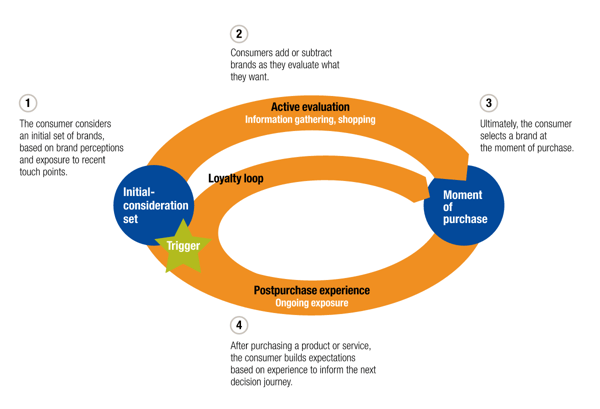
How Social Media has Changed the Game for Advertisers
Traditionally, the consumer’s path to purchase has been most commonly described in terms of a funnel, starting from awareness to conversion and retention. However, with customers having more touchpoints than ever to interact with brands, that journey is no longer such a straightforward one.
Perhaps a more accurate depiction of the path to purchase can be found in McKinsey’s consumer decision journey model, which is circular rather than linear.

“People form impressions of brands from various touch points, including advertisements, news reports, conversations with family and friends and product experiences.” - McKinsey
How Social Media has Changed the Game for Advertisers
One of these touchpoints that is becoming increasingly important for brands is social media.
The Early Days of Social Media
In the early days of social media, brands still treated it very much like another broadcasting channel for “push” marketing. When Facebook changed its algorithms to prioritize content from friends and family instead of Pages, organic reach declined drastically. Brands that kept organic engagement alive on their Pages were the ones with something relevant to say to their customers, the ones that customers wanted to keep on interacting with.
Introduction of Facebook Ads
When Facebook introduced its advertising offerings, it gave advertisers a chance to reach the same customers as long as they were willing to pay for it. Then, Facebook’s algorithms changed yet again, to prioritize ads that are deemed relevant to customers and that customers are likely to engage with. Once again, brands had to have content worth spending time on in order to reach customers on social media.
Despite Facebook’s changes requiring advertisers to put more effort into their social media ads, social media ad spend continues to increase. This year, social media advertising (including on Facebook, Instagram, and Twitter) is set to hit $70 billion. The proportion of the marketing budget allocated to social media, meanwhile, will exceed one third for most companies.
What this Means for Advertisers on Social Media
Advertisers know that the audience they want to reach is on social media. But at which stage of the buying journey is their audience? On social media these days, their audience could be in any or all of the stages, from awareness to retention. And their journey through the stages is cyclical, as described in the McKinsey model above.
This is why marketers need to take into consideration every stage of the funnel when determining their strategy for managing user engagement. Performance marketers tend to focus heavily on the later stage of the buying path - specifically conversions. However, the comments that appear on the ads can affect brand perception, which then impacts retention as well as consideration.
Meanwhile, branding advertisers running awareness campaigns tend to focus on the earlier stages of the buying path - reach and awareness. Many tend to leave user queries to their customer service teams, which then get funneled into a ticketing system. But not all of these comments may be service-related. Some of them may be from prospective customers demonstrating purchase intent (Example: “Where can I buy this?”).
Not responding to these questions promptly and treating them separately from service tickets (Example: “My order has not yet arrived!”) not only means a missed sale. Unattended comments also leave a poor impression on all the viewers of the ad when they see the brand is not engaged.
Optimizing Every Stage of the Buying Path on Social Media
It’s important to think of social media as a touchpoint for every stage of the buying path, and optimize for each stage accordingly. Brands cannot continue to operate in silos where performance marketing or acquisition / growth handles one part of social media in complete isolation from community management or customer service, tasked to handle another part of social media. To maximize results and drive sales, all stages from awareness to conversion and to loyalty need to be considered holistically. How can that be done? Stay tuned for our next blog post on how to optimize the customer journey at every stage of the buying path.